Having a Blue Galah Cockatoo means having an affectionate, loyal, and sweet companion. Bright blue rings around the eyes distinguish this cockatoo and it has a tall yellow-and-white crest that it often raises when perched.
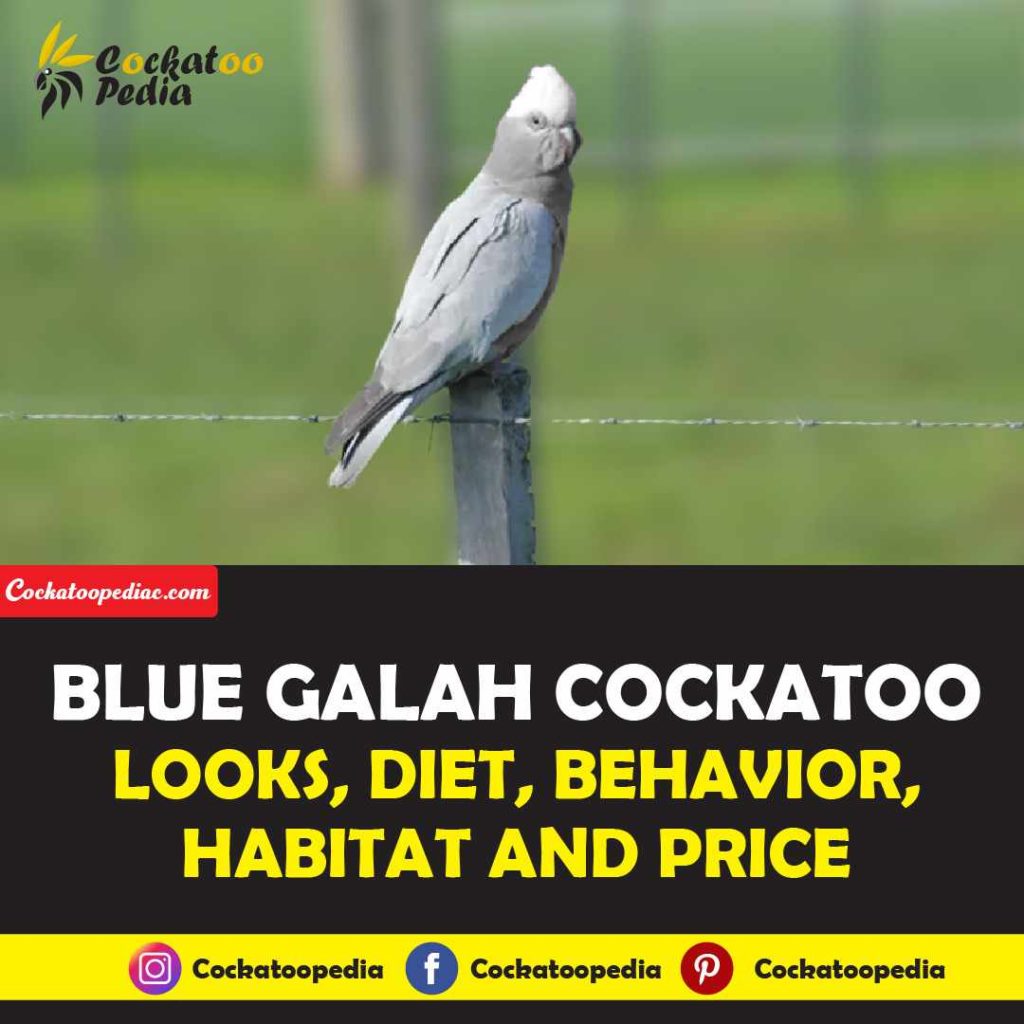
These are extremely rare, often common around villages at the forest edge, and prefer tropical forests up to 100 meters of elevation. Blue-eyed cockatoos demand a lot of your attention and are considered sociable pets; that’s why they are called the “Love Sponges.”
Blue galahs are wonderful pets, but they can become extremely challenging to own without adequate attention due to their size. If you are planning to adopt or buy a blue galah; extensively research this beforehand.
Therefore, you will find this guide handy; here you will find everything you need to know about the Blue Galah cockatoo, including its looks, voice, living pattern in forests and captivity, and diet.
Blue Galah Cockatoo
Blue galah seems a hybrid of Corella or Moluccan cockatoo however blue cockatoo is itself a sub-species of cockatoo and looks quite different from these two species. Blue-eyed cockatoo is an extremely rare bird and hard to find; typically they’re found in tropical-subtropical forests of the Lowland.
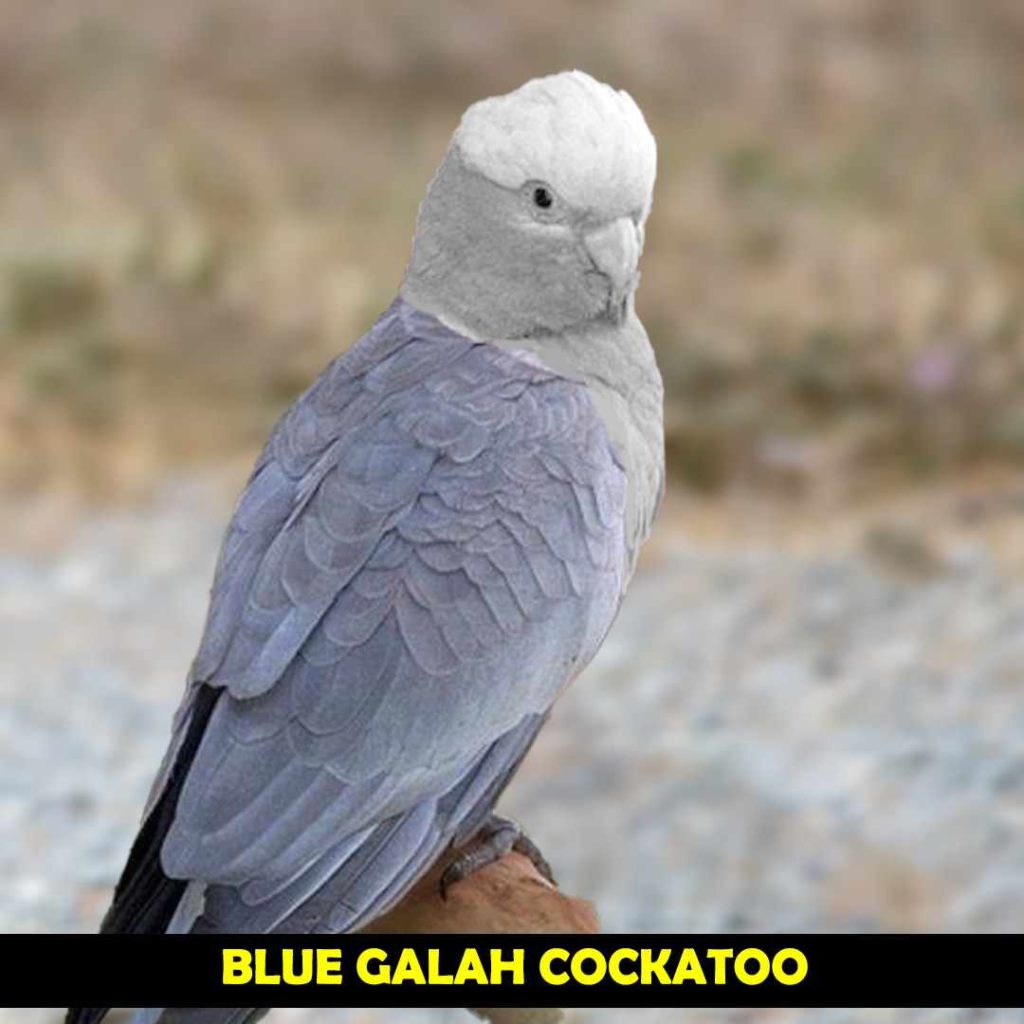
Blue-eyed cockatoo is also known as Blue galah and this is native to New Ireland and New Britain (Papua Guinea). Blue Galahs love to fly in flocks and can b seen at high altitudes. They can be distinguished by their screeching calls while flying.
One of the biggest species of cockatoos, the blue galah cockatoo is about 50 cm (20 in) long with a black beak and light blue rims around its eyes.
Relatively unusual among family species, the Blue cockatoo has zygodactyl feet; in which 2 fingers have a forward direction and 2 have a backward direction to catch things while standing on one leg.
Scientific Name of Galah Cockatoo
Blue galah cockatoo is a member of large cockatoos and native to Ireland and New Britain.
They are called by many names such as Blue-eyed cockatoo, white black-billed cockatoo, and Blue-eyed cockatoos.
It falls in the Cacatua genus and the species is Ophthalmicaaka; its scientific name is Cacatua ophthalmica.
How Does a Blue Galah Cockatoo Look?
Blue-eyed cockatoos grow to be about 50 centimeters long, are mostly white, and have erectile yellow and white crests, black beaks, and dark grey legs. and featherless skin surrounding the eyes. These traits give them their name.
Sometimes people know it as yellow-crested or sulfur-crested, however a blue cockatoo has quite a different appearance and a brighter blue eye-ring.
Blue-eyed cockatoos can be very demanding, yet make great & affectionate pets. These are renowned for being one of the friendliest and affable pets in cockatoos.
They do lively interaction with owners like mimicking, perching on shoulders, and playful engagement. Though lack of interaction can lead to hormonal changes, health issues, and feather plucking.
The juveniles have very similar appearances while determining sexes; some males have dark brown irises while some females have reddish-brown irises. Despite this small difference, there is often no reliable way to distinguish between males and females based on the color of their iris.
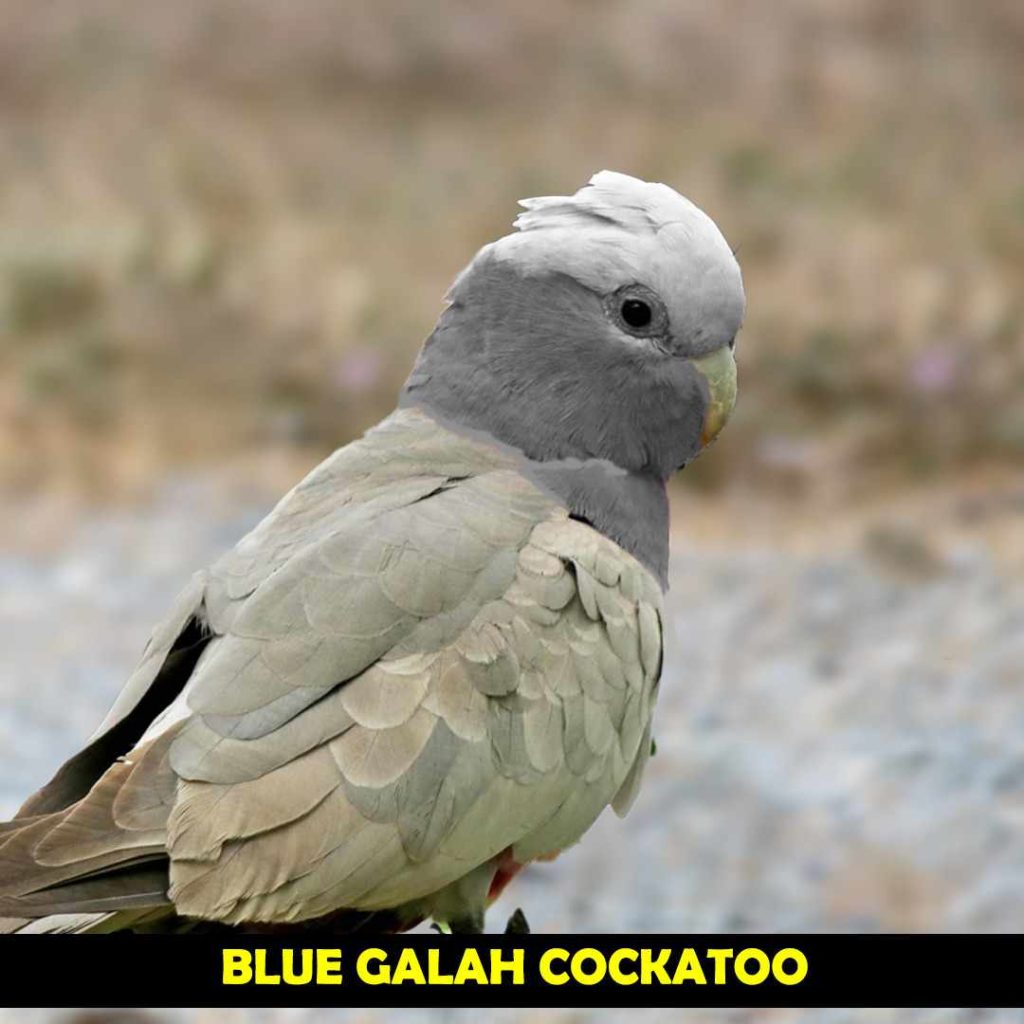
Despite having no bright colors, this parrot is a graceful, sociable, and aesthetically pleasing bird.
Voice of Blue-eyed Galah Cockatoo
Blue-eyed are considered noisy birds in captivity and in the wild. Blue galah emits loud screaming sounds and has an obstructive voice. They’re also very loud while flying.
They like to mimic human voices, repetitive sounds like horns, doorbells, rings, etc. The only hack; patience is needed when this continues for a long time and very loudly.
You can minimize your pet’s need for vocalizing by providing more time, toys, engagers, and social interaction with them. If your pet seems excessively loud, it is likely to be a result of boredom or neglect. Be sure to spend some time with your pet.
Size and Weight of Blue Galah Cockatoos
Blue eye galah is a large cockatoo and at the time of maturity, their size can be average between 45 to 50 centimeters in length with a mobile crest and a black beak. And usually, it weighs around 18 – 20 Oz (500 – 570 grams).
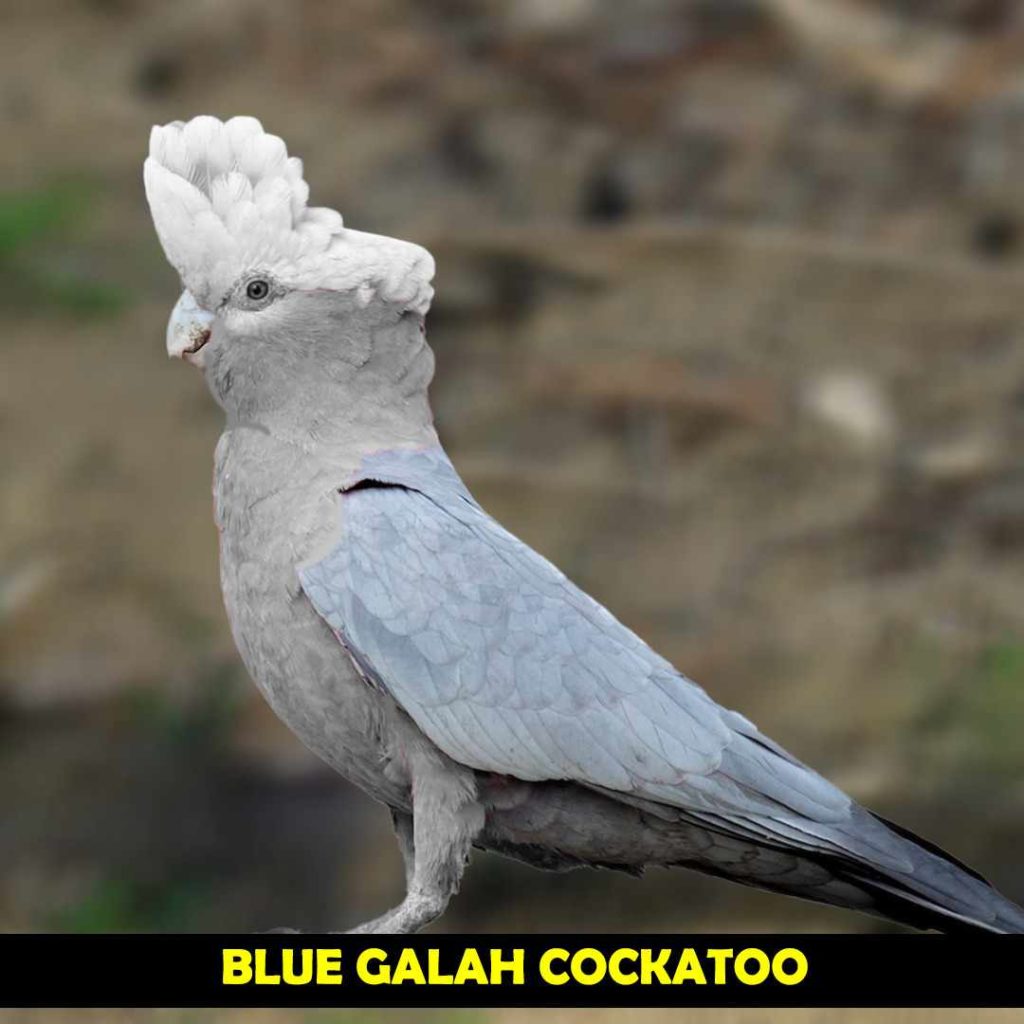
Where Do Blue Galah Cockatoo Live?
Blue cockatoo inhabits only in the Bismarck Archipelago, which lies close to eastern New Guinea. These are found in tropical/subtropical lowland forests of New Ireland and New Britain.
Blue galah love to fly high and is typically sighted at 3000+ feet altitude. Wild galahs nest in thick primary forests instead of gardened forests, where these islands make up the Blue-Eyed cockatoo’s nest. Blue cockatoos made their nests on 40+ m high trees.
Meanwhile, keeping the cockatoo in captivity is challenging. It’s quite high maintenance and attention-conscious pet. It needs a very spacious habitat to walk, to live, to destroy things, and to fly. At the very least, it needs a 7-9 foot-square cage. A spacious cage will be a good choice for their well-being.
The Blue cockatoo bird wants to spend considerable time with you. If you are short on time for interaction, this bird can be happier with some other attractions; you should put some perches, chewable, mineral blocks, etc in the cage. Also, give some time to fly outside the cage, this will keep them happier and healthier.
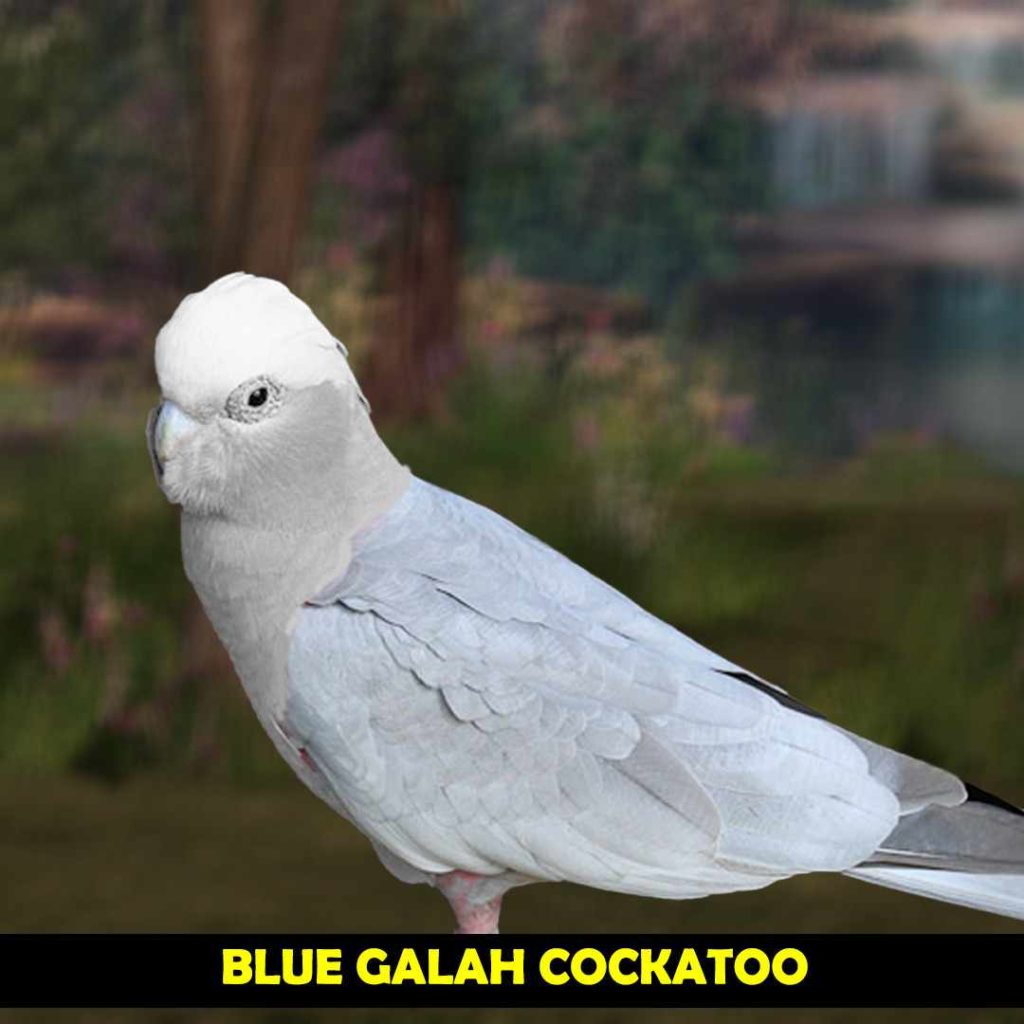
I spend with Soneri ( my blue Cockatoo) almost 2 hours daily, cuddle him, affectionately kiss him, and Soneri play with my hands, hairs, give me a lovely bite, and perches on my shoulder. Whereas if I go out for a day or two, my blue galah misses me, emits loud sounds for attention, or plucks their feathers.
I would never say that they are easy to care for; I know that they get a lot of attention. It’s a huge commitment so if you are thinking about getting in a blue-eyed cockatoo; you’re going into a lifetime bond.
What Does Blue Galah Cockatoo Eat?
Primarily Blue-eyed Galahs feed on seeds, nuts, and fruits. This species of cockatoo enjoys eating a variety of natural seeds, herbs, nuts, fruits, and tree blossoms, as well as insects and larvae for some additional proteins.
In captivity, they also need a balanced diet full of essential supplements including carbos, protein, and vitamins. According to their wild behavior; they like to eat chopped fresh fruits, green veggies, apples, oranges, celery, flowers, and leaf buds.
As well as you can add seeds, almonds, pulses, beans, formulated pellet mixes, and salmons for a well-balanced diet. A balanced diet for an adult-sized pet should contain 1/4 cups of pellets and 1/2 cups of fruits, grains, and vegetables.
In captivity, they also need fresh drinking water regularly and you should arrange baths for them occasionally.
Breeding Behavior of Galah Cockatoo
Blue galah is a pretty, sociable, loving house pet and is recognized as friendliest in the cockatoo family world widely. According to some reviews and my personal experience; these are most playful, enjoy the engagement, cuddling, and being handled.
Blue cockatoo retains many features of other cockatoo species. Like others, it has a unique feather crest on the head that signifies their mood e.g. angry, ready to play, or frightened.

They’re very smart, fast learners and can mimic human speeches. Blue cockatoos are noisy both in the wild and in captivity. They love to emit different tunes when happy, screeching sounds while flying or upon being frightened.
They need a lot of attention and engagement. Blue galah would do weird things all time i.e. perches upside down, hanging, destroying chewable, scratching furniture or branches.
You should provide them different kinds of chew toys, wooden branches, and eatables to keep them stimulated and occupied. It’s the best way to occupy them in case if you have a lack of time; however insufficient attention may cause feather plucking and hormonal changes.
As we discussed earlier, they require pretty much attention; rescuing blue galah will be a perfect choice for you if you’re planning to buy. Spend some time daily with your pet, play with them, preps healthy for your bird, and provide them with enough engagement.
If you can handle all this, then this really might be the right bird for you.
The lifespan of Galah Cockatoo
Surprisingly their lifespan in the wild is longer than in captivity; the average lifespan of blue-eyed cockatoo is 40years in captivity and 50-60 years in the wild. Inadequate attention, diet, and care are the causes that decrease their lifespan in captivity.
Galah Cockatoo Population
This species is considered vulnerable and blue cockatoos are extremely rare in the wild and captivity. However its population is declining, as of 2012 blue eyes, cockatoos population ranges between 10,000 to 15,000.
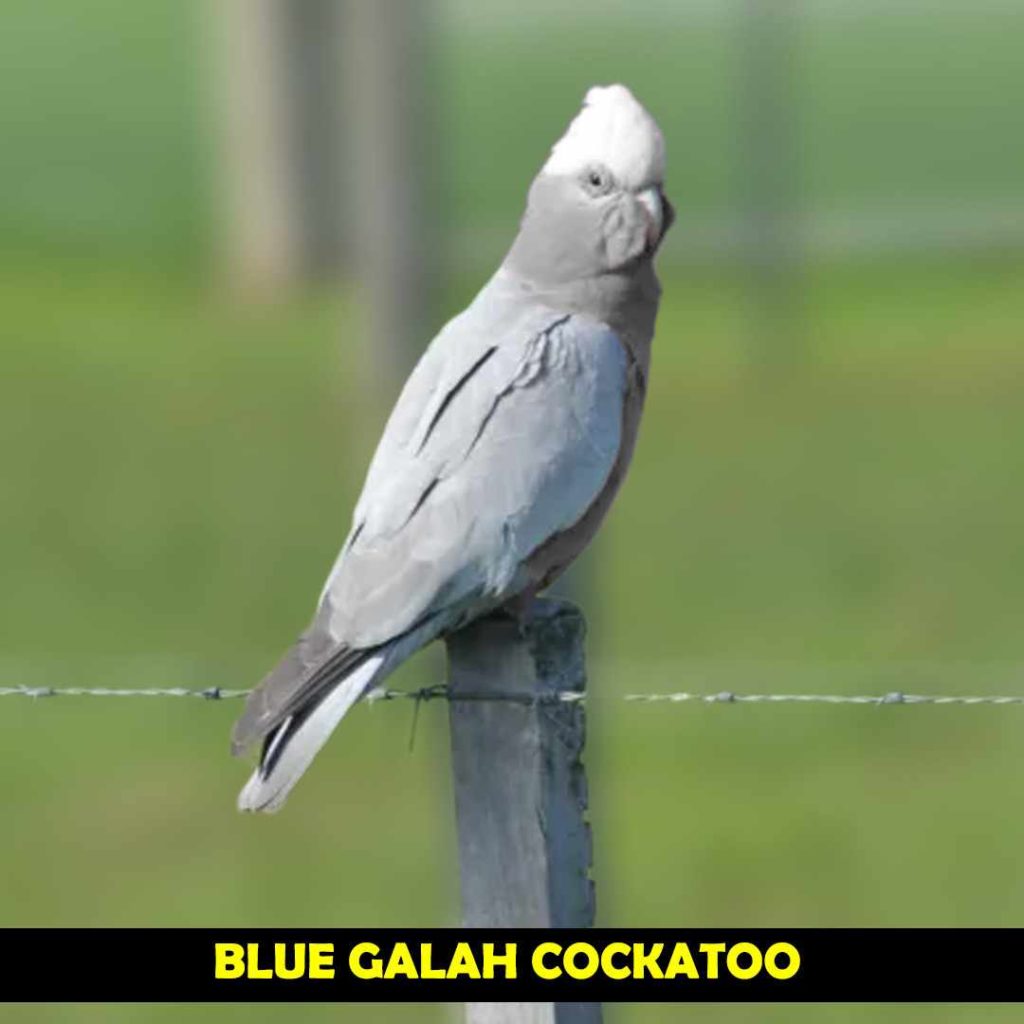
Threats to Galah Cockatoos
The most significant threat to this species is the rapid degradation and clearance of lowland forests. According to some observers; forest clearance by companies for oil plantations is responsible for this. Blue cockatoos made their nests in these forests, and clearing of forests has an effect on breeding that is a cause of the decline in the population. This is likely to have caused a significant loss of breeding habitat.
The illegal trade of blue-eyed cockatoos is also a cause. A lot of traps are found that might be used to catch the blue galahs, even some tree branches are glued to capture them.
This cockatoo is not found in less densely forested areas, such as “forest gardens” like other bird species from these forests that have the ability to flourish in other less densely forested areas.
Some threats to Blue Galah in captivity
- Common diseases i.e. feather-picking, Lipomas, Polyoma, PBFD, Psittacosis, and Giardia
- Obesity and an unbalanced diet
- Don’t give them just seeds or pellets; you should use fruits, nuts & salads in their diet.
- Don’t use scented candles or air fresheners; they’re sensitive respiratory system
- Don’t use essential oils and hair spray near the bird
- Avoid the use of Teflon pans for cooking they emit harmful chemicals
- Never use harsh chemicals to clean the room or cage
- Keep your bird outside while repairing at home like painting etc
How Much Galah Cockatoo Cost?
Blue-eyed cockatoos are rare in the wild and captivity and are very hard to find. Normally they can cost upwards of 10,000 dollars because of their rarity.
Other Similar Species
- Rose-breasted cockatoo – Albino
- Rose-breasted cockatoo – Blue Galah
- Rose-breasted cockatoo – Lutino
- Moluccan cockatoo – Lutino
- Salmon-crested Cockatoo
- Sulphur-crested Cockatoo
- White Umbrella Cockatoo
- Correla
Conclusion
Blue-eye Cockatoos are much calmer and affectionate than other cockatoos, which are quite mischievous and energetic. The Blue-Eyed cockatoos love doing tricks and playing with their toys. They like interacting with people and they like to perch on your shoulder when you handle them.
In no time, this graceful bird will bond with you. Plus, their long lifespan assures you they’ll be your lifelong companion!
Also Read About: Greater Sulphur Crested Cockatoo

